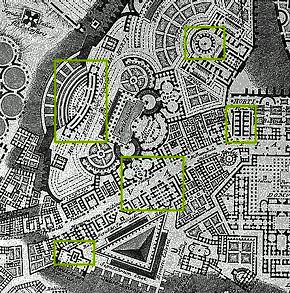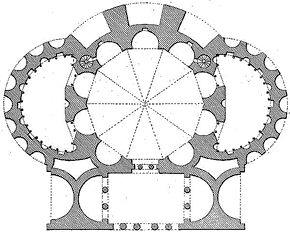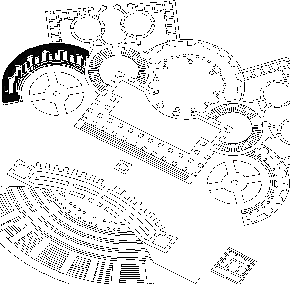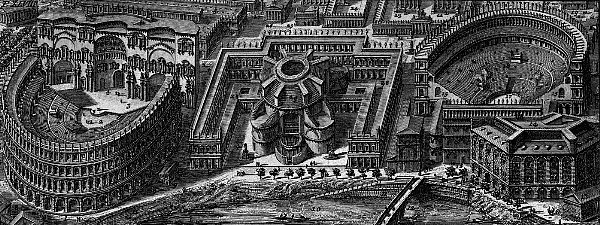2011.07.12 18:58
Question about Charles Jencks' Declaration
Jencks: "Rather than a deep extended attack on modern architecture, showing how its ills relate very closely to the prevailing philosophies of the modern age, I will attempt a caricature, a polemic. The virtue of this genre (as well as its vise) is its license to cut through the large generalities with a certain abandon and enjoyment, overlooking all the exceptions and subtleties of the argument. Caricature is of course not the whole truth. Daumier's drawings didn't really show what nineteenth-century poverty was about, but rather gave a highly selective view of some truths. Let us then romp through the desolation of modern architecture, and the destruction of our cities, like some Martian tourist out on a earthbound excursion, visiting the archaeological sites with a superior disinterest, bemused by the sad but instructive mistakes of a former architectural civilization. After all, since it is fairly dead, we might as well enjoy picking over the corpse."
Who knew?!?
And they say, history is no mystery. OR When in doubt, blame the butler.
2011.11.07 10:25
Quondam's Fifteenth Anniversary
"The compositional innovation manifests itself further with rich resources in the Burial Place of the Augustan family ("Bustum Caesaris Augusti") and the Gardens of Lucilian ("Horti Luciliani")."
--Vincenzo Fasolo, "The Campo Marzio of G. B. Piranesi" by Vincenzo Fasolo first appeared in Quaderni dell'Instituto di Storia dell'Architecttura, n.15 - 1956, published by the Faculty of Architecture at the University of Rome.
Fasolo's essay on Piranesi's Ichnographia of the Campo Marzio is relatively rare among Campo Marzio literature in that it presents a straightforward description and analysis of Piranesi's urban design, yet it nonetheless harbors factual errors and misinterpretations. This essay also formed the groundwork of Tafuri's later interpretation of Piranesi's large plan.

5. Above all, the nymphaeum of the Orti Liciniani, then and still known as the temple of Minerva Medica. Alberti's inclusion of the decagon among his shapes for churches is, no doubt, due to this prototype.
--Rudolf Wittkower, Architectural Principles in the Age of Humanism (1962), p. 5.

"...finally, the group dominated by the Bustum Caesaris Augusti, an imposing collection of regular and irregular geometric forms one grafted on to the other according to the law of opposition. (Attention is also called, in passing, to the appearance of two phallic-shaped planimetric organisms converging on the hexagonal atrium, which foreshadow, perhaps with no other intent than a pure ludus geometrico, the project of Ledoux's Oikema and some of Soane's typological notions.)
But it is in the Horti Luciliani that the mechanical architecture of Piranesi reaches an extreme level of abstraction. Here, a complex of structures in semicircles and in sectors of circles obeys the rule of gemmation, as they revolve around the Atrium Minervae: an astonishing mechanism, in which Piranesi achieves the maximum refinement of his geometric instruments."
--Manfredo Tafuri, The Sphere and the Labyrinth - Avant-Gardes and Architecture from Piranesi to the 1970s (Cambridge: The MIT Press, 1987), p.36.

1998.04.29
The other discovery deals with the horti Luciliani and the horti Lucullani.
Piranesi places the fictitious horti Luciliani where the horti Lucullani ought to be, and places the horti Lucullani at a location further north. It is the horti Lucullani that Messalena murdered for.
Lucilius is the father of Roman satire. Is there anything satirical in Piranesi's plan of the garden? Perhaps the answer has something to do with a shrine to Minerva being in the center of one of the building complexes--literally "wisdom" (but also "weaving") in the center of a garden of satire. The theater and salons, now make more sense.
satire 1 a : an ancient Roman commentary in verse on some prevailing vise of folly b : a usually topical literay composition holding up human or individual vices, folly, abuses, or shortcomings to censure by means of ridicule, derision, burlesque, irony, or other method sometimes with an intent to bring about c : LAMPOON 2 a : a branch of literature ridiculing vice or folly
censure 1 : a judgement involving condem-nation a : spiritual chastizement by an ecclesiastical agency
wit implies intellectual brilliance and quickness in perception combined with a gift for expressing ideas in an entertaining, often laughter provoking, pointed way, usually connoting the unexpected or apt turn of phrase or idea and often suggesting a certain brittle unfeelingness
satire can apply to any criticism or censure relying on exposure, often by irony and often subtle, of the ridiclous or absurd qualities of something
The notion of Piranesi being satirical himself throughout the Ichnographia is an intriguing idea.
...the various other gardens and buildings that Piranesi places on the same plateau as the horti Lucullani. Some of them, like the horti Narcissi, relate directly to the Messalena story since it is the freedman Narcissus that ultimately kills Messalena. There is also the horti Anteri--Anteros means "an avenger of slighted love," which describes both Messalena and her husband the emperor Claudius, although for different reasons.
...Tafuri could have said so much more about the horti Luciliani.
| |
2013.11.21 21:36
21 November
Read this earlier today:
At times, too, I've had the impression that I'd manage to feel quite at home in a life of vacuity. That the relatively painless boredom would enable me to go on making the usual gestures of life. Another big mistake. Prolonged boredom is not tenable as a position: sooner or later it is transformed into feelings that are acutely more painful, of true pain; this is precisely what's happening to me.
Maybe, I tell myself, this tour of the provinces is going to alter my ideas. Doubtless in a negative sense, but it's going to alter my ideas; at least there will be a change of direction, a shake-up."
That's how part one of Houellebecq's Whatever ends. I think it's a great passage, but I found myself laughing as I typed it here. I guess because it sounds so dark, but a sad, dull dark. Does it perhaps describe archinect/forum these days? I'm laughing again.
Modeling Ichnographia Quondam is taking a lot of time, and I'm promising myself that the model will actually be used.
Remember the ideas for filling up Independence Mall. It's always fun to act on ideas that occur to you while in the shower.
2013.12.27
27 December
In the course of the "play" the most egregious "mistake/inversion" is the misplacement and disorientation of the Circus Flaminius and its actual exchange with the Theater of Balba. This "mistake" manifests a composition of inverted theaters--essentially a double inverted theater. This configuration becomes one of the Il Campo Marzio's final scenes and thus represents the double inverted "theater" of Rome's own history--the narrative of pagan Rome and the narrative of Christian Rome, and in the Ichnographia the one story is indeed a reflection of the other.

2001.11.26
Piranesi's Continual Double Theaters
The subject of double theaters starts with Bernini's play--the Baroque ending for sure--and it is Piranesi that continues this Baroque design technique. Oddly, the double theater aspect of Piranesi's design methodology has yet to be recognized by designers or design theorists or critics.
A short list of Piranesian double theaters:
1. check for possible examples in the Prima Parte.
2. the two states of the Carceri.
3. Wilton-Ely's example of mirrored precedent for one of the Carceri.
4. the overall double--Pagan-Christian--narrative of the Ichnographia Campus Martius, with the Scenographia as the empty stage set.
5. the double directional Triumphal Way.
6. the axes of life and death.
7. the axes of love and war.
8. the Mars - St. Agnes axis.
9. the theatrics of satire--Horti Luciliani.
10. the (literal) double theaters-- Marcellus and Balbi.
11. the "circus act".
12. the back versus front of the altar.
13. the two sets of cochinae--is the snail its own double theater in that it self propagates, i.e., fulfills both sex roles individually? does this relate to the intercourse building?
14. the "rise and fall" (of Imperial Rome) as delineated by the two Busti Busti.
15. it seems a case could be made regarding the working together of two mediums-- plan delineations in combination with Latin labels.
| |
2014.04.18 11:47
As demolition of Folk Art Museum begins, Archinect reflects on historical implications
If you want to talk about all this from the point of view of mistakes, then it's fairly self-evident that it was a mistake to build the American Folk Art Museum in the first place.
2014.04.18 15:17
As demolition of Folk Art Museum begins, Archinect reflects on historical implications
The biggest piece of evidence is that the building was abandoned by the very institution that the building was built for. That's not to say that the building itself is what made the American Folk Art Museum abandon it, but there's no denying that the American Folk Art Museum could not sustain the building. Also, I think it's a fairly safe assumption that the American Folk Art Museum thought a high-profile building (which manifested as a highly idiosyncratic building) at a prime location adjacent the Museum of Modern Art would only add to the institution's and building's sustainability, and, as the present process of demolition makes extremely evident, that turned out to be a mistake as well. I just don't see how MoMA can be blamed for those mistakes, nor that MoMA [is or] was ever responsible for fixing them.
2014.04.07 18:00
Panel rejects design for Eisenhower Memorial
Susan Eisenhower's June 20, 2013 statement, "Lastly he [Dwight D. Eisenhower Memorial Commission Chairman Rocco Siciliano] repeated again that my brother, David, had voted for the Gehry design, when in fact David supported the concept of another architect." really is provocative, and perhaps even ambiguous. It could mean that at the time when different architect's designs were being voted on that David did not vote for Gehry's design, but after Gehry's design was chosen, he then went along with the Commission's decision. In any case, I don't think that Susan is all out telling an untruth.
I find this also provocative: "Mr. Gehry told my sister and me last year that the metal scrims are a non-negotiable part of the memorial design – the element that makes this a Gehry." Did Susan and her sister then think, "What does he think this is then, a Gehry Memorial?"
If Gehry really said that, then that's what is most likely this Memorial's biggest design mistake.
2015.01.27 18:07
Quo vadis, Charleston architecture?
It seems that Charleston is now more involved with setting an agenda then it is with being sensitive to its built environment. With guidelines/restrictions comes a loss of sensitivity. It was a mistake to reject the new Clemson design because it truly exhibited a whole range of sensitivity/sensibility. Were the design actually built, I strongly suspect it would have been a real positive asset to its environment. Guidelines and restrictions, by default, engender a packaged sensitivity, which soon enough boils down to boredom, if not all out kitsch.
|